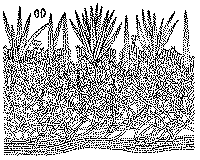|
 Hymenochaete dictator Hymenochaete dictator
BiostatusPresent in region - Indigenous. Endemic
Images (click to enlarge)
Caption: PI. 2, fig. 3. Hymenochaete dictator G.H.Cunn. x 1. Showing colliculose surface deeply
areolately creviced. White colonies are of a Corticium. | 
Caption: FIG. 17. Hymenochaete dictator G.H.Cunn. Transverse section x 500; spores x 1000.
Showing setae aggregated into fascicles of 5-11, also scattered setae in context, and cortex
without abhymenial hairs. |
Article: Cunningham, G.H. (1957). Thelephoraceae of New Zealand. XIV. The genus Hymenochaete. Transactions of the Royal Society of New Zealand 85(1): 1-51.
Description: Hymenophore resupinate, annual, reviving a second season, membranous, becoming brittle,
adnate, at first composed of numerous irregularly orbicular colonies 2-10 mm diameter,
becoming merged to form linear areas to 7 x 2 cm. Hymenial surface bright cinnamon, darker
towards the centre, finely tuberculate, velutinate, becoming deeply areolately creviced;
margin thinning out, fibrillose, light cinnamon or fulvous, adnate. Context fulvous, 110-250 µ
thick, of loosely intertwined hyphae bordered on the abhymenial surface by a narrow coloured
cortex of loosely intertwined hyphae, without abhymenial hairs; hyphal system monomitic;
generative hyphae 2-2.5 µ diameter, walls 0.25 µ thick, pallid yellow brown, freely branched,
septate. Setal layer to 130 µ deep, composed of fascicles of 4-12 setae arising in the
subhymenium, mainly in the tubercules, of scattered setae forming 2-3 vague overlapping
rows, and of setae scattered in the context and arising from its base; setae projecting to 50 µ,
subulate, some narrowly fusiform, 40-80 x 6-9 µ, walls naked, yellow brown, lumina narrow.
Hymenial layer to 30 µ deep, hyaline, a close palisade of basidia and paraphyses. Basidia
subclavate, 14-18 x 4-5 µ, 4-spored; sterigmata slender, arcuate, to 6 µ long. Paraphyses
subclavate, same diameter but shorter than the basidia. Spores elliptical or obovate, 5-6.5 x 3-3.5 µ, walls smooth, hyaline, 0.2 µ
thick.
Habitat: HABITAT: Effused on bark of dead branches associated with a white rot.
Distribution: DISTRIBUTION: New Zealand.
Notes: Fascicles of setae arise mainly from tubercules in bundles of 3-12, with solitary setae
between; scattered setae are also present in the context. The cortex is without abhymenial
hairs, and composed of compacted, partly cemented parallel hyphae. From H. lictor the
species is separated by the tuberculate surface of different colour, narrower context hyphae
with thinner walls, different structure of the cortex, greater number of setae in the fascicles,
differently shaped basidia and paraphyses.
|